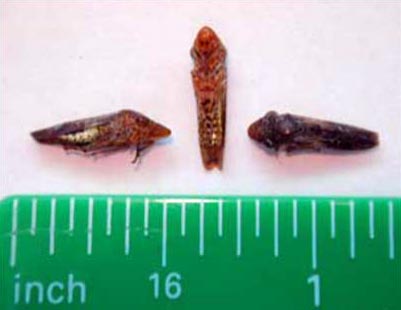A few years ago, Ms. Lori Gavitt, the very skilled and knowledgeable resident horticulturist-arborist at the Reserve Golf & Country Club in Southern California was kind enough to host my visit to the club. During this tour, Ms. Gavitt pointed out the abnormal and apparently debilitating Mycoplasma infection afflicting the palo verde trees planted in abundance throughout the course and club grounds.
The palo verde tree (Cercidium microphyllum) is representative of the artistically-draped flora of the Southwestern states of Arizona, Southern California, New Mexico and Nevada. This beautiful tree was ideally suited for the colorfully painted and silhouette contrasted setting sculptured by the club’s gifted landscape architects.
But the infection running rampant through the palo verdes was beginning to undermine the otherwise seemingly flawless motif.
Symptomology of MLO
The palo verde trees on the club grounds featured many structures at the terminus of numerous branches that are known as “witch’s broom.”

Witch’s broom is typified by multiple branches arising at extremely short intervals, somewhat resembling a zinc deficiency in which the shortened internodes give rise to a similar symptom also referred to as “witch’s broom.”
The condition appears to weaken the integrity of the newly formed and extended shoots, many of which are attenuated, thin and without tissue density. By the end of the season, the tips of these weakened shoots succumb to either heat stress attrition and/or freeze stress attrition. Over the 45+ years I have had an opportunity to be a grower and to study and conduct research in the area of plant physiology, plant pathology and horticulture; I have been exposed to a plethora of maladies. The above, described symptoms coincide repeatedly with works I have conducted on various plant species, also manifesting closely related or identical symptomatology.

The symptom described above is typical of what is referred to as a mycoplasma disease, which is caused by a group of parasites collectively referred to as mycoplasma-like organisms (MLO). Basically, a mycoplasma is a highly specialized and evolved bacterium that lacks a cell wall. It has shed this cell wall to gain a more intimate communication with its host, upon which this organism has become entirely dependent upon for its sustenance (it has become an obligate parasite). The pathogen is vectored and transmitted to a wide variety of hosts by the feeding of various species of the leafhopper (Class Insecta: Order Homoptera: Family Cicadellidae, Example: glassy winged sharpshooter, Homalodisca coagulata).

The “deep feeding” characteristics of the leafhopper singles this genus out as the premier vector. It is not only the deep feeding directly into the vascular cylinder of the host, but the quantity of sap taken and delivered into the host plant. This high titre of inoculum delivered via the glassy winged sharpshooter (GWS) is what prompted me to ask Ms. Gavitt if the first viewing of this disease happened to fall in a time frame of approximately 7 years passed. She responded with a definitive confirmation of the first sightings of unusual growth. The GWS first showed up in California about 8 years ago, and it generally requires roughly 1 year’s incubation before distinct host symptoms are expressed.
What made me suspect the GWS as the vector is that it is a deep feeder in the xylem tissues of the host. Native species (such as the palo verde tree) which have evolved in parallel with parasites such as MLO generally require an higher inoculum and generally with feedings repeated over several hours to several days. This characterizes the GWS, and further, the leafhoppers are capable of reproducing and multiplying the parasite within their bodies. Hence, once infected, a leafhopper can serve as a vector for the rest of its life.
The GWS was observed in California for about 2 to 3 years, and then faded out of the scene. This is one of the reasons as to why pathologists have not observed too many new strikes of this disease, nor do they implicate the GWS when it does arise—the insect is scarce, or not found at all.
Because the MLO has the capacity to drain the carbon-energy reserves of the host as well as to infuse the palo verde tree with various toxins, it is capable of eventually killing the tree directly or indirectly. Furthermore, MLOs characteristically elicit the imbalanced production of and mobilization of various growth hormones. As a consequence, many of the classic symptoms are similar to an unpredictable imbalance of growth hormones, and in almost all cases, the ensuing growth and development of tissues are distorted, weak, of low density and highly susceptible to both physical and pathological challenges.
Management of MLO Diseases
Obligate parasites—parasites that cannot reproduce without their hosts—develop intimate associations with their hosts over millions and millions of years. The level of communication that must exist for this host-parasite relationship is nothing short of miraculous and precise, for if it were not for this high degree of communication, the parasite would perish. Furthermore, were it not for the ability of the host to receive intricate communication from the parasite, the host would suffer far more than it does.
In order to fully appreciate this delicate association of parasite and host, we need to again realize that it is indeed a case where the parasite is an obligate parasite, and as such the survival and extended well-being of the parasite requires that the host is always kept alive, as the parasite would kill itself were it to kill the host.
For our purposes, to describe a successful parasitic relationship in which a parasite is actively metabolizing and reproducing in a compromised host, I shall refer to the susceptible host as being in “Stage I Host Physiology,” and the parasite as being in “Status A Metabolism.”
The intricate and precise communication of most interest to us deals with the host’s communication of its ability to mount a defense response. A successful defense response is marked, for one, by the de novo production of numerous derivatives of phenolic compounds, typically produced by what is known as the Pentose Phosphate Pathway (PPP). Among the numerous compounds are those which have the ability to inactivate the growth and development of the parasite (MLO). We shall refer to this heightened state of host physiology with the maximized expression of Resistance to be in a “Stage II Physiology.”
Unless the parasite is capable of detecting this sudden change in the host biochemistry, it would begin to attempt growth and development, only to find an abrupt end to its existence. However, having reached a point of time in evolution where the host-parasite relationship is one in which both coexist, the parasite, too, must have developed a means of both detecting the presence of a dangerous environment and then be able to transform its physiology from active metabolism to one of quiescence. This quiescent state of the parasite is referred to as “Status B Metabolism.”
In this state of quiescence, the parasite shifts to an ametabolic state in which no metabolic processes occur. In this ametabolic state, the parasite is capable of being innocuous to the otherwise toxic array of defense compounds produced by the host. The parasite escapes the throes of the defense response and will await another moment in time when the defense response of the host is compromised. In a state of compromised health, the host does not mount a timely nor effective defense response. In such cases, the parasite’s detection of this compromised health status instigates renewed metabolic activities, including replication. We shall refer to this susceptible state as Stage I Physiology.
Diseased trees are presently in the following status:
Stage I Host Physiology + State A Parasite Metabolism
(The tree is diseased with active metabolism of the MLO)
We desire to achieve the following:
Stage II Host Physiology + Quiescence of Parasite
(The tree is expressing resistance and has arrested further symptoms while placing the parasite into a state of nonmetabolic quiescence.)
We then wish to proceed to:
Stage II Host Physiology + Remission of Parasite → Total Recovery
In this state, the tree is expressing resistance, and has not only arrested new growth and development temporarily in the host, but has taken charge and caused the mortality of the MLOs. Furthermore, the tree has regained its efficient physiological function and is operating at a very high level of metabolic efficiency. This scenario is the ultimate goal of the programs to follow. This and sister programs have been especially effective in the total recovery of various species of plants from such serious (and labeled as terminal) diseases as:
- Pierce’s Disease of Grapes
- Leaf Scorch of Almonds
- Tobacco Mosaic Virus of Tomatoes
- Spotted Wilt of Peppers
- Alfalfa Mosaic Virus of Alfalfa
- Prunus Necrotic Ringspot Virus (PNRSV) of Almonds
- PNRSV of Cherries
- Cucumber Mosaic Virus of Cucumbers
- CMV of melons
For information on how to achieve MLO parasite remission in palo verde trees and other species, such as those described above, contact Sunburst Labs about our plant disease testing and remedial program services.

